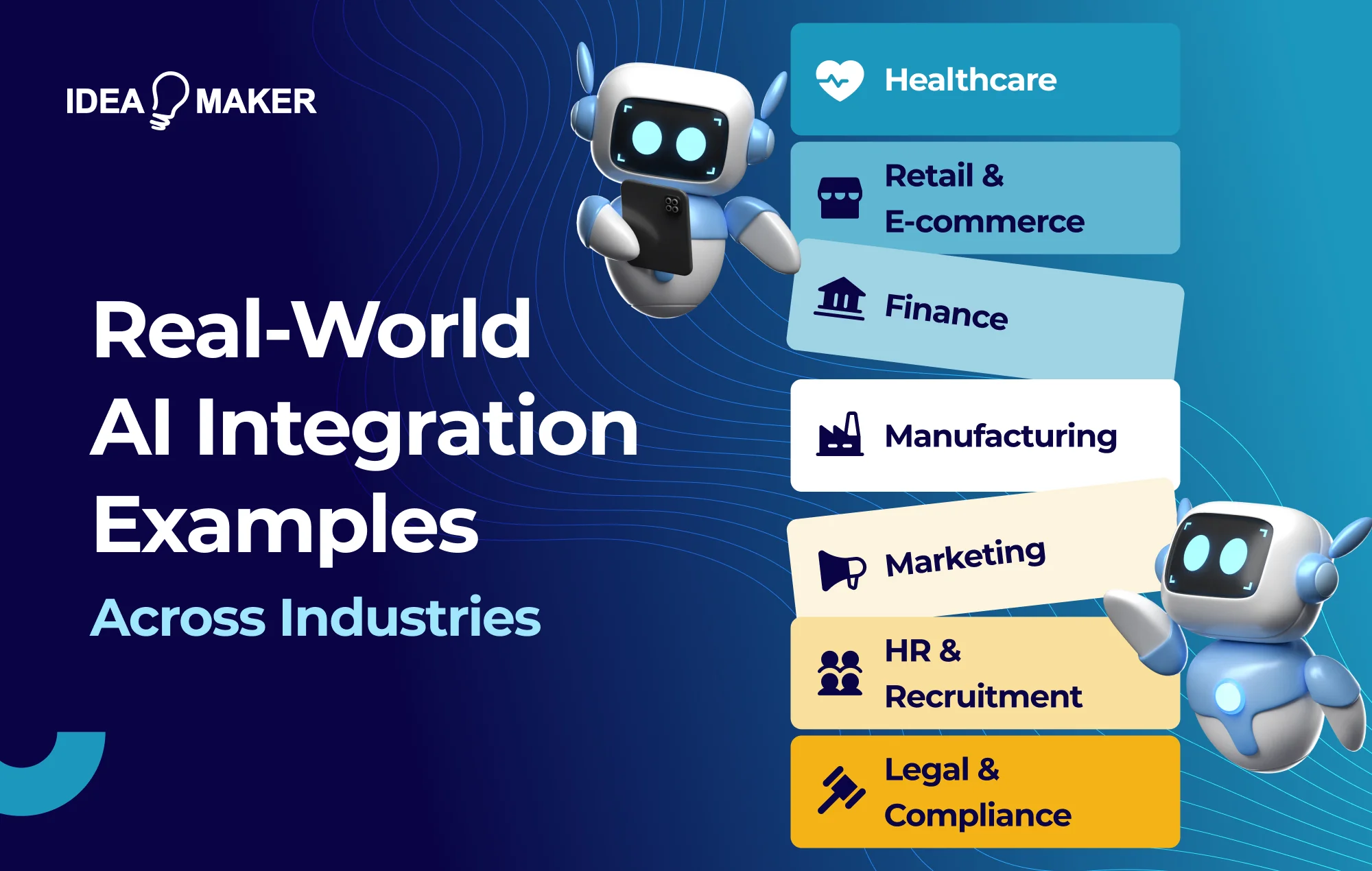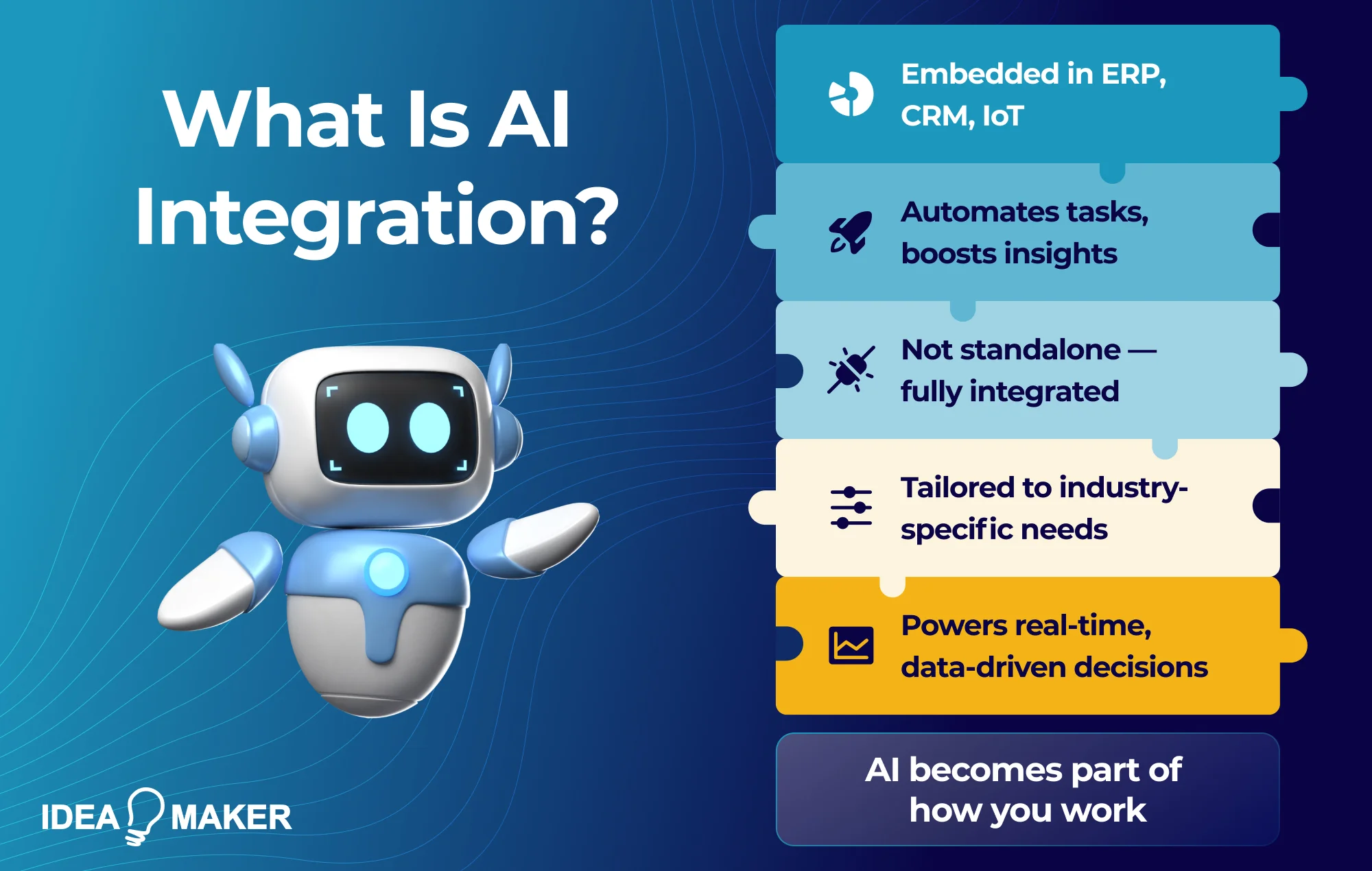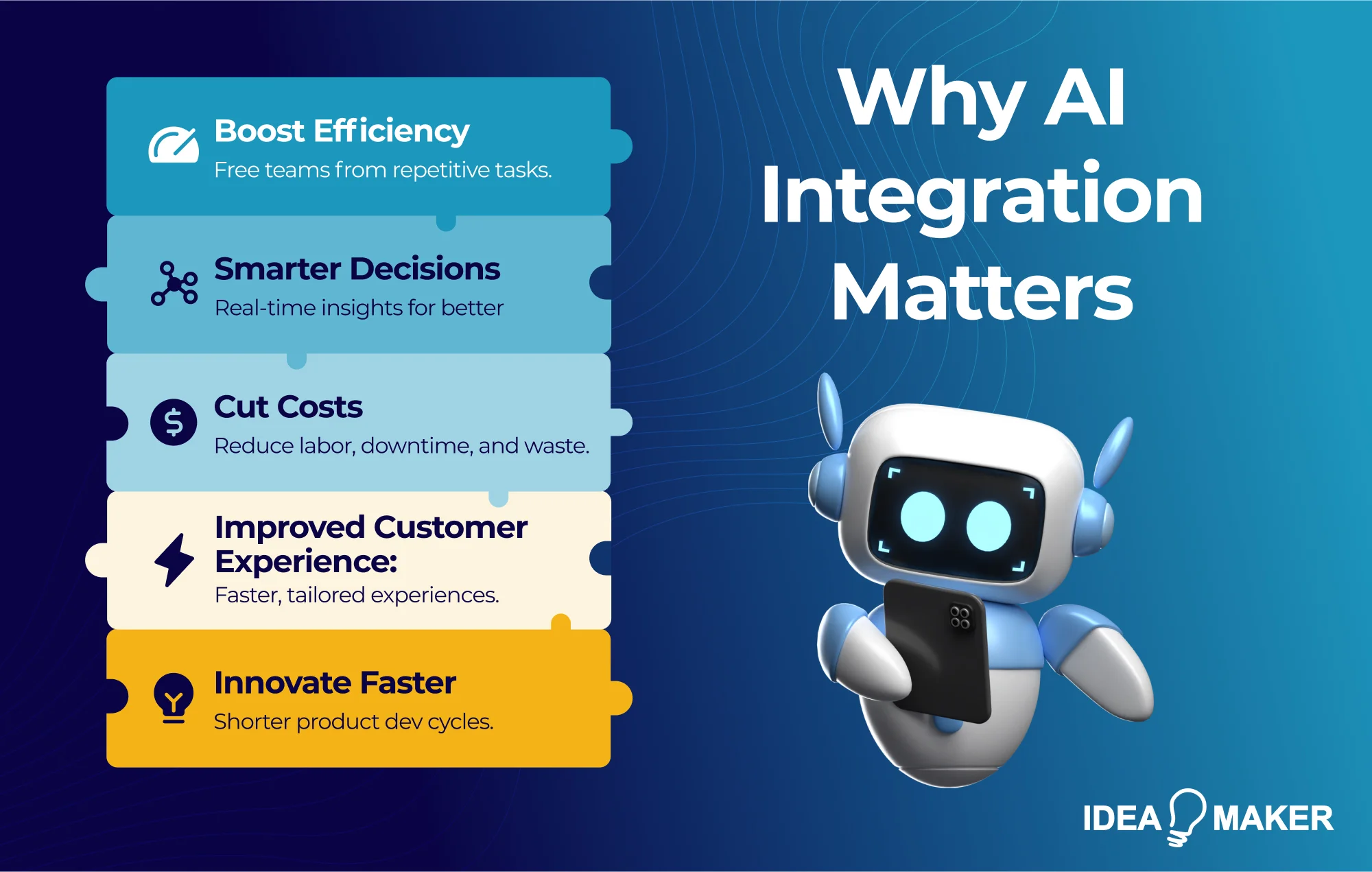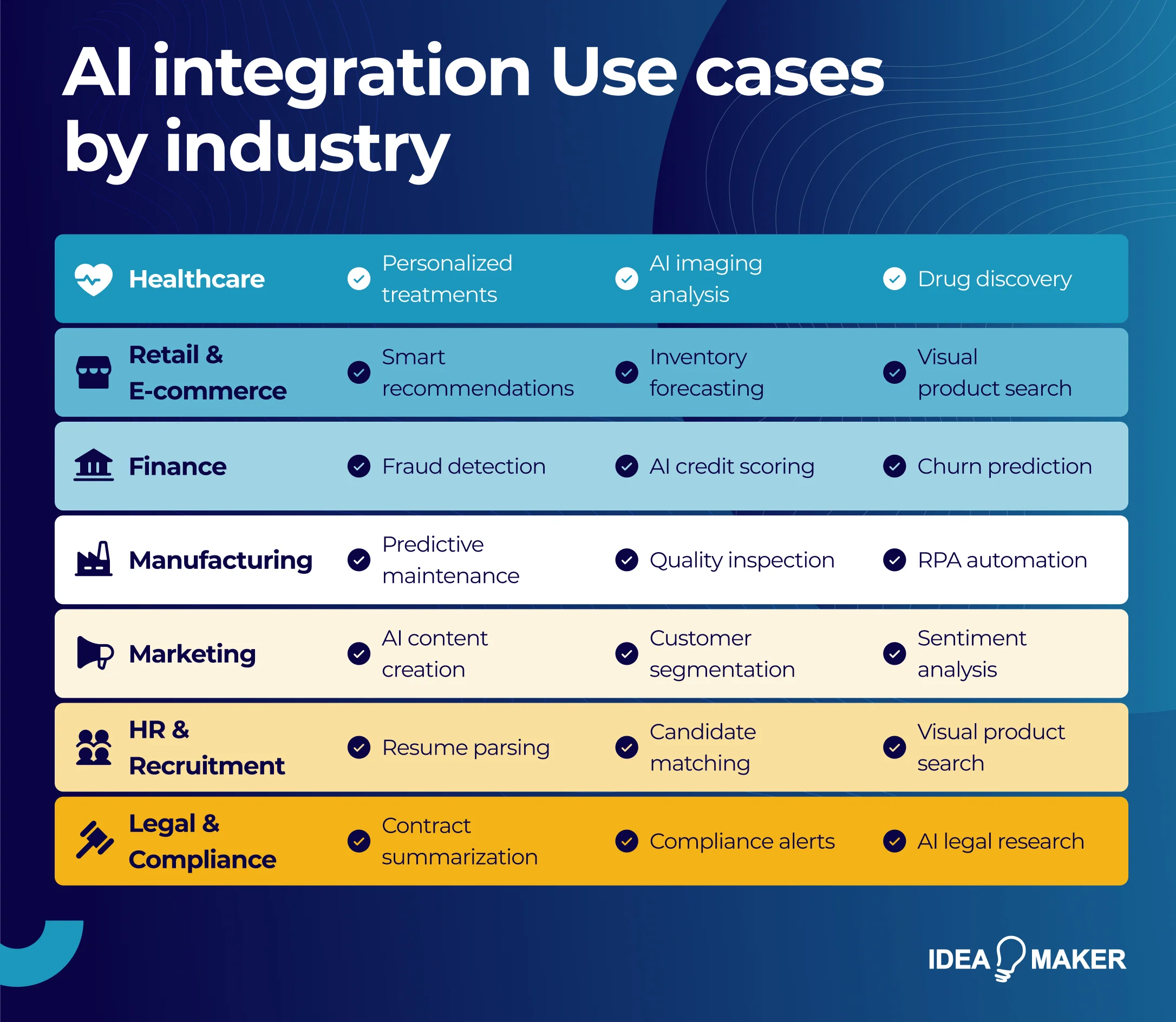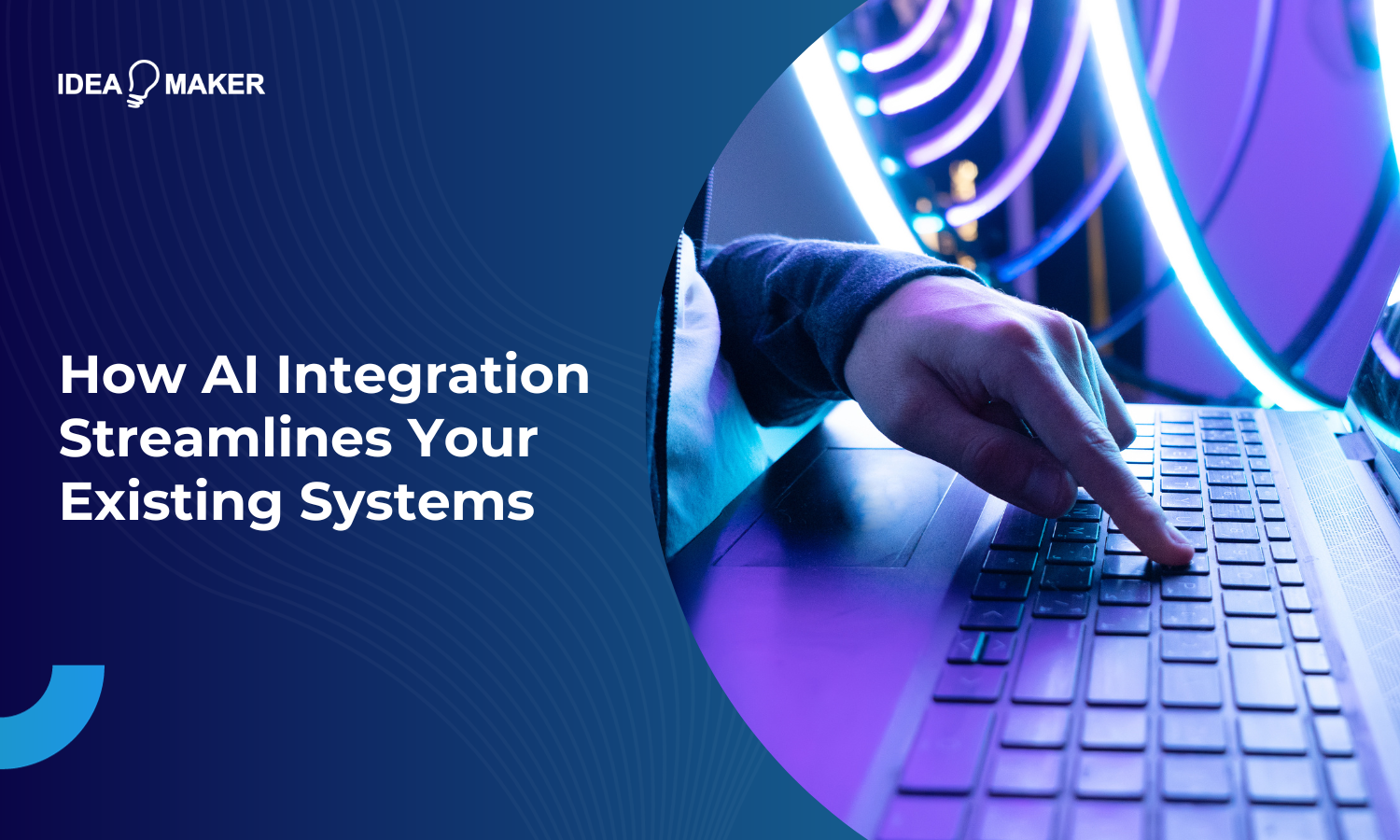Artificial intelligence is transforming the way industries operate, compete, and serve customers. From hospitals using AI to find diseases early to retail giants optimizing their supply chains in real-time, the impact is tangible and quantifiable. In fact, 77% of companies are either using or considering the use of AI, according to a report by IBM.
But how, precisely, is AI being put into practice, and what can you learn from those who are leading the way? This article provides in-depth coverage of AI integration examples across various industry verticals, highlighting how it enhances their operations, ROI, and reduces manual efforts. You’ll also get a clear picture of how AI development services can be tailored to your specific business needs through AI integration examples.
Table of Contents
What Is AI Integration?
AI integration is the process of embedding AI technologies (like machine learning, natural language processing, and computer vision) into business systems, workflows, or applications. The goal of integrating AI is to automate tasks, uncover valuable insights, increase profit, and make faster, data-driven decisions.
Rather than functioning as standalone tools, AI tools and platforms are built to work alongside ERP platforms, CRM software, IoT devices, or customer service platforms to make operations more innovative and efficient. This integration can be industry-specific, for example, predictive maintenance in manufacturing or fraud detection in banking.
Effective AI does not mean you install a chatbot or an analytics dashboard. It demands careful attention to business needs, clean and well-organized data, and strong collaboration across technical and non-technical aspects of the business. When done well, AI is integrated into routine operations, rather than a bolt-on feature.
Why AI Integration Matters for Modern Businesses?
AI has become a “must-have” to remain competitive, not a “nice to have.” In the era where speed, ease of use, and customization are the markers of success, firms that integrate AI into their operations will have a significant competitive edge. It’s not just about the adoption of new technologies; it’s about altering how value is imagined and delivered.
Let’s examine how AI implementation delivers tangible value to business outcomes and future growth:
- Operational efficiency: AI takes over monotonous chores, reduces error rates, and accelerates operations, freeing up human teams to do more meaningful activities. Tasks such as invoice processing, which previously took hours, can now be completed in minutes with AI-based document parsing.
- More intelligent Decision-Making: AI’s ability to process vast amounts of data in real time allows companies to develop sharper insights and more accurate forecasting. It means better decisions, whether about pricing strategy, risk management, or customer targeting.
- Cost Savings through Scale: AI reduces labor costs, waste, and downtime, as it optimizes resource efficiency and avoids expensive downtime through predictive systems, which leads to significant long-term savings.
- Improved Customer Experience: With AI, companies can provide quicker and more tailored service, whether it’s recommendation engines based on unique user behavior or a real-time AI chatbot. These enhancements lead to customer loyalty and higher retention rates.
- Shorter Product Development Cycles: Automating tasks such as data analysis, A/B testing, and AI helps teams move faster from idea to prototype. This acceleration enables businesses to innovate more quickly, reduce time-to-market, and be more agile in adapting to changes in customer requirements.
AI Integration Examples by Industry
AI applications in business are delivering real value by addressing specific problems, optimizing processes, and enhancing decision-making. The following provides a deeper dive into how AI implementation is being adopted across various industries, including specific AI use cases and case studies.
AI in Healthcare
AI integration in healthcare remains the most transformative area to date, and one of the few where it is used to help patients and providers, rather than just streamline administrative paperwork. In 2025, 80% of hospitals now using AI to improve patient care and operational efficiency.
- AI for Personalized Treatment Plans: AI is utilized to analyze patient information, including medical history, genetics, and lifestyle habits, to recommend personalized treatment options. For example, AI can help oncologists design custom chemotherapy regimens based on a patient’s genetic mutations and how similar cases responded to different drugs.
- AI Integration in Medical Imaging Analysis: AI is incorporated into radiology software to detect anomalies in X-rays, MRIs, and CT scans. Aidoc and Zebra Medical are two such tools for faster screening scans.
- Chatbots for Patient Engagement: Hospitals and clinics are integrating AI into patient management applications to reduce administrative burden and enhance patient engagement. For example, appointment scheduling, symptom checking, follow-ups, and medication reminders.
- Drug Discovery: AI augments R&D pipelines and dramatically decreases time-to-market and capital expenditure to market new drugs. Exscientia uses generative AI throughout its drug discovery cycle, which leads to 70% acceleration in drug design and 80% reduction in capital costs.
AI in Retail and E-commerce
Retailers and e-commerce businesses are using AI for personalization to enhance operations and the overall shopping experience online and in real life. Some examples include:
- Personalized Product Recommendations: AI suggests targeted products based on real-time user browsing history, purchase behaviour, and preferences to enhance customer experience and revenue. Amazon and Shopify stores utilize recommendation engines to boost conversions and increase the average order value.
- Inventory Forecasting: AI models provide better demand prediction, accounting for historical sales data, seasonality, and current trends to minimize overstock or stockouts. Thus increasing their profit and enhancing supply chain throughput. Interestingly, Super-Pharm improved inventory accuracy by up to 90% using Vertex AI.
- AI-Powered Customer Service Bots: Retailers implement bots across web, app, and messenger channels to answer customer inquiries, provide order/tracking details, and handle returns, thereby lowering response times and human workload.
- Visual Search Integration: Through AI, customers can search for products through images to find similar items. Pinterest and ASOS utilize visual recognition to locate in-stock items that match users’ uploaded photos to enhance product discovery and engagement.
AI in Finance
AI integration in the finance sector strengthens risk management, decision-making, and faster customer services through the following use cases:
- Fraud Detection Systems: AI assesses financial transaction patterns in real-time to identify suspicious behavior and alert authorities. Banks deploy such models to quickly prevent fraud. Using AI agents, a leading UK bank achieved a 35% reduction in fraud incidents through real-time AI fraud detection.
- AI in Credit Scoring: Conventional credit scoring is based on a limited financial history. AI extends this capability through alternative data, such as spending habits and digital activity, to evaluate creditworthiness more inclusively for underbanked customers.
- Algorithmic Trading Platforms: AI-powered trading tools analyze massive data in the market and predict trends to place trades rapidly. Hence, financial services firms take advantage of momentary opportunities for better decision making.
- Customer Churn Prediction Models: AI models predict which clients are likely to leave based on usage patterns, support interactions, and transactional behaviour. Hence, companies plan proactive retention strategies at the right time.
AI in Manufacturing
In manufacturing, the goal of the AI integration process is to automate tasks, reduce downtime, and ensure product quality and operational consistency in the following ways:
- Predictive Maintenance using Sensor Data: AI analyzes real-time data from IoT sensors embedded in machinery to identify potential wear and tear patterns in equipment to minimize unexpected downtime and extend the life of the equipment.
- Computer Vision for Quality Control: Computer vision-based AI systems inspect production line output for defects or non-conformities, faster and more accurately than can be achieved through human-centric manual checks. This guarantees a better quality of the product and less wastage.
- Robotic Process Automation (RPA): Robots perform routine, rule-based tasks, such as processing invoices, updating customer records, and extracting data from documents. An international manufacturing client used RPA to save over 90 monthly man-hours and 96% processing time for their operations.
- Supply Chain Optimization Using ML: ML models optimize inventory levels and delivery reliability based on the analysis of demand patterns, supplier performance, and logistics data, to create a flexible and robust supply chain.
AI in Marketing
In marketing, AI helps gain greater customer insights, faster content creation, and more targeted campaigns to deliver measurable ROI through the following use cases:
AI-driven Content Production: Marketers leverage AI-based technologies such as ChatGPT and Jasper to produce relevant and personalized blog posts, product descriptions, email copy, and ad assets in a fraction of the time.
Customer Segmentation via Clustering Models: AI groups customers by similarities in demographics, preferences, and behavior to help marketers fine-tune messaging, offers, and campaigns for each segment to increase engagement and conversion.
Sentiment Analysis of Brand Mentions: AI tracks public sentiment around a brand or product by monitoring social media responses, reviews, and forum mentions in real-time. Marketers utilize these findings to optimize campaigns and prevent problems from escalating. A leading E-commerce retailer increased 25% customer satisfaction rates and decreased 15% negative reviews on social media after implementing AI-powered sentiment analysis.
Dynamic Pricing Tools: AI tools analyze demand, competitor pricing adjustments, stock levels, and customer behavior, and adjust pricing automatically in real-time to maximize revenue and compete in markets like e-commerce and travel.
AI in HR and Recruitment
AI helps HR teams to simplify the recruiting process, enhance candidate experience, and scale data-driven talent decisions in the following ways:
Resume Parsing With NLP: AI-based applications leverage NLP to sift through resumes and pull out the essential data, such as skills, experience, and education, to cut manual screening times for recruiters and remove bias in early-stage filtration.
AI-Powered Candidate Matching: AI optimizes the hiring process by identifying the most suitable candidates for a specific role. Volkswagen Group of America efficiently mapped 4,000 unique job descriptions to 3,200 job roles.
Chatbots For Pre-Screening: AI-driven chatbots are integrated into our software to perform primary tasks of interacting with a candidate (screening questions, availability, FAQs) to optimize the hiring process and provide communication for early-stage recruiting.
Sentiment-based Performance Feedback Tools: AI can analyze written reviews and communication styles to provide sentiment-based insights into employee feedback. HR teams utilize these tools to identify top performers, detect potential issues early, and inform better leadership decisions.
AI in Legal and Compliance
AI-powered tools are enhancing legal operations while ensuring compliance by automating repetitive work, minimizing human error, and shortening decision-making time through the following use cases:
Contract Review and Summarization: AI tools process long contracts and summarize them by isolating important clauses, obligations, and risks. This speeds up review cycles, enhances accuracy, and enables legal teams to concentrate on more critical issues. Through automated contract review, JPMorgan Chase reduced annual staff hours from 360,000 to less than 2,000. It translates to approximately $32 million in yearly time savings.
Legal Research Automation: Millions of existing court cases, regulations, and legal authorities can be dynamically compared with databases within seconds by AI systems. The technique reduces research time by a substantial factor and increases the quality and volume of legal argument.
Compliance Monitoring With Anomaly Detection: AI continuously monitors transactions, communications, and system logs to detect potential compliance violations or unusual patterns.
E-Discovery Tools With NLP: AI-driven E-discovery tools sort through the massive documents, emails, and records to identify relevant evidence quickly during litigation or internal investigations, to speed up the process and lower legal costs.
Common AI Tools Used for Integration
The process of incorporating AI into your business begins with selecting the right tools. Every tool is designed to serve various AI business use cases. The right tool is the one that aligns with your business needs, complexity level, budget, and technical level.
Today’s market offers a wide range of AI tools and platforms, from no-code solutions to custom model development. Choosing the appropriate tools depends on your industry, business goals, and technical maturity.
Below are widely adopted platforms that support scalable and efficient AI applications in business:
-
OpenAI (ChatGPT API, Whisper, DALL·E)
OpenAI provides one of the most widely adopted and advanced AI toolkits for integrating AI into your systems.
- With the ChatGPT API, businesses can now create their own conversational AI agents to power a range of applications, including customer support, knowledge assistants, internal productivity tools, and sales bots, all while interacting in a human-like manner.
- For voice workloads, OpenAI Dev has a real-time transcription service called Whisper for speech-to-text, which is well-suited to meeting logs, voice commands, recorded customer calls, and accessibility.
- DALL·E creates images from custom text prompts for creative industries, such as marketing and e-commerce, to generate visuals that optimize their design process.
-
Google Cloud AI / Vertex AI
Google Cloud AI offers a powerful set of tools for image recognition, language processing, and other forms of machine learning. What distinguishes Vertex AI is that you can manage the end-to-end ML life cycle, including all the data ingestion and preprocessing, model training, evaluation, deployment, and monitoring, from a single, integrated console. It’s fully integrated with BigQuery and Looker as well, providing easy access with your business intelligence workflows to shorten the time to insight and time to impact.
-
AWS SageMaker
Amazon SageMaker is an end-to-end service for the machine learning lifecycle. It covers the entire AI pipeline for data preprocessing, model training and evaluation, hyperparameter tuning, and model deployment. The strength of SageMaker is in itís flexibility, providing pre-built algorithms and AutoML features out of the box for beginners. At the same time, advanced users can build a custom pipeline with a high degree of flexibility using Jupyter notebooks and custom container support. It’s also closely integrated with the wider AWS environment (such as S3 for storage and Lambda for compute) to offer a powerful solution for cloud-native businesses looking to scale their AI integration without significant overhead rapidly.
-
Microsoft Azure Cognitive Services
Azure provides plug-and-play APIs for vision, speech, language, and decision-making. Because they are pre-trained and production-ready, they can be easily integrated quickly, securely, and at scale, perfect for enterprises seeking quick wins in AI-powered business applications. Some use cases include language translation, facial recognition, form processing, and sentiment analysis.
-
IBM Watson
IBM Watson is most recognized for its NLP, business automation, and AI governance capabilities. It is widely used in areas where explainability, accountability, and compliance are essential, such as AI in finance, healthcare, and legal services. Among Watson’s capabilities are contract analysis, customer service automation, chatbot development, and document classification. What sets Watson apart is its enterprise-level hybrid and multi-cloud capabilities for companies with complex infrastructure or sensitive data conditions.
-
Hugging Face Transformers
Hugging Face Transformers is an open-source library of community-provided transformers with hundreds of high-quality pre-trained models in NLP, vision, audio, and more. Organizations with expert data science teams prefer Hugging Face for its openness, transparency, and community-led development. It’s a suitable tool when you want to craft a custom AI pipeline that has costly tools and fine-grained control, such as document summarization, named entity recognition, topic modeling, or multilingual translation.
Companies processing proprietary or domain-specific content (such as legal, academic, or healthcare documents) profit from Hugging Face’s customizable architecture, which makes it the top choice for AI development services looking for complete ownership and in-house fine-tuning.
-
Zapier + AI APIs (no-code integration tools)
Zapier connects AI tools to business applications such as Gmail, Slack, or CRM systems. For startups, small businesses, or non-technical teams, Zapier provides an easy-to-set-up connection between mainstream business software and AI solutions and platforms, no code required.
Through AI APIs such as OpenAI or Google Cloud, Zapier automates tasks like email triaging, sentiment analysis, customer outreach, and message personalization. For instance, an e-commerce firm can use Zapier to extract customer data from Shopify, run sentiment analysis using an AI API, and deliver automated follow-up emails via Gmail, all without a developer.
Steps to Successfully Integrate AI into Your Business
AI integration requires structured and strategy-driven planning to deliver business impact. Without thoughtful planning, even the best models can fail to deliver ROI. Here’s what contemporary businesses should be seeking to accomplish:
-
Identify Clear Business Problems
Start by pinpointing the specific problems or inefficiencies you want AI to address, such as reducing customer churn, automating manual data entry, or predicting demand. The more precisely defined the question, the easier it is to measure the impact of AI. Remember that:
- The goal must be business-driven, not technology-driven.
- Well-defined use cases can justify the investment and measure the ROI after deployment.
- Avoid vague goals like “improve operations.” Instead, think in terms of targeted KPIs like “decrease order processing time by 30%” or “increase upsell conversion in email campaigns.”
-
Assess Existing Infrastructure
Before you bring AI on board, though, consider what your current tech stack, workflows, and data pipelines look like. How prepared are your systems to integrate AI into existing systems? Are your tools and technology compatible with the most recent AI APIs or models? AI tools will present a less significant hurdle for cloud-native and modular companies.
Companies with more developed IT infrastructure, such as those already running on AWS, Azure, or GCP, will have an easier time adopting AI. Integrating with older or “legacy” systems may take further middleware or layers of data transformation.
-
Choose Between Off-the-Shelf Tools vs Custom Models
You don’t always have to start from scratch for an AI solution. Whether you need a custom vs off-the-shelf AI model, take your decision based on your budget and timeline, and whether the problem you’re trying to solve is relatively straightforward or complex.
Choose:
- Off-the-shelf tools (e.g., Salesforce Einstein, Google Cloud AutoML) can accelerate deployment and support standard application use cases, such as customer segmentation or churn prediction, for less complex business problems.
- Custom models for more complex or specialized business requirements when off-the-shelf models fall short, and when you need enhanced domain expertise or have proprietary data.
-
Ensure Data Readiness and Compliance
Your data is the gasoline that runs AI, but garbage data results in garbage. Clean, annotated, well-organized datasets are crucial for training accurate models.
- Verify the integrity of data for inputs, such as customer profiles, logs, transactions, and external feeds.
- Compliance is also non-negotiable. Data Handling Depending on the industry, companies need to comply with regulations such as GDPR, HIPAA, or PCI-DSS when handling data.
- Not every company realizes just how much work is involved in that. It is often the most extended and crucial phase of the AI deployment process.
-
Start Small (Pilot Project) and Scale
No need to “AI everything” right away. Begin with a narrowly defined, high-impact project to prove feasibility and collect internal heads of agreement. Examples of good pilot use cases that can be automated include automating invoice tagging, forecasting low inventory alerts, or categorizing customer service tickets.
- Pilots need to fly on live data with real users, not sandboxes.
- Leverage these early wins to tailor your approach, estimate ROI, and confidently scale.
- Additionally, a successful pilot is a great way to uncover hidden costs, integration problems, and change management hurdles before full-scale deployment.
-
Train Teams and Monitor Post-deployment
AI isn’t a one-time setup; it’s a living system that requires ongoing maintenance, monitoring, and iteration. Educate both technical and non-technical personnel on how decisions made by AI systems can be tracked and refined.
- Incorporate feedback loops: incessantly monitor performance, refine models, and feed new data in.
- Own it, someone has to be accountable for AI model drift, user adoption, and performance reporting.
- When you combine those humans with the technology, you maximize your odds of long-term success.
FAQs: Understanding AI Integration
What’s the difference between AI development and AI integration?
AI development is the process of building new models from scratch. On the other hand, AI integration refers to the process of embedding existing AI models into business processes to enhance operational efficiency.
How long does AI integration take?
Depending on the complexity of the use case, simple integrations (such as chatbot deployment) can take a few weeks. At the same time, more complex projects (like predictive analytics systems) may require several months.
Can small businesses integrate AI tools?
Yes. These days, many AI tools are offered as SaaS applications with minimal entry cost, and even small businesses can afford to start using them through plug-and-play solutions.
Do you need in-house data scientists to integrate AI?
Not necessarily. While complex custom models may require technical expertise, many off-the-shelf AI tools are designed for easy integration and can be managed by usual developers or experts, or with the help of external consultants.
Need Help Integrating AI Into Your Business?
Whether you’re trying to streamline your internal operations, improve customer experiences, or make more informed data-driven decisions, successfully adopting AI depends on having the right strategy, tools, and expertise.
At Idea Maker, we help businesses at every step of the AI journey from pinpointing the proper use cases to creating & deploying custom AI solutions. We collaborate with you to ensure every integration is realistic, scalable, and delivers value for your business.
Get a free consultation today, and let us make your AI vision a competitive advantage.
AI Integration Examples: Final Thoughts
AI is now a competitive factor that transforms the operations of every industry, whether it’s healthcare, finance, marketing, or manufacturing. The applications discussed in this article demonstrate how AI addresses real business challenges with tangible value. But successful execution with AI is not just about the tools; it’s also about thoughtful integration, well-defined goals, and the right implementation partners.
Start small and stay focused, and collaborate with an experienced team that is well-versed in both technology and business. Properly integrated, AI can transform your operations and your results.
